|
I introduced this dish at a recent dinner party and it was a big success. The idea is that everyone receives a plate with a little parchment paper packet. When they cut it open all of the flavors escape and they find the surprise inside. Here’s how to put it together. Other types of fish such as snapper or salmon are suitable as well for this preparation. Ingredients (serves 4-6):
-2 pounds halibut -1 cup preferred olives -1 lemon -1 garlic clove, thinly sliced -olive oil -white wine CONFIT Take 3 different types of your favorite olives (such as picholine, nicoise and Greek – you’ll need about a cup), the rind of 2 lemons (just the yellow part, cut into thin strips), one garlic clove (chopped coarsely) and 3 sprigs of fresh thyme. In a medium size pot heat 1/2 cup of olive oil over medium heat. Add the garlic and sautee for 1 minute (do not brown). Add all of the other items and cook–stirring frequently–for 2 minutes. Set aside. FISH On the same day you intend to serve the dish go to your fishmonger and buy the freshest fish possible. I like to use Wild Halibut but take whatever is most fresh. I’d stick to a white fleshy fish such as halibut or sea bass. However, even black cod or mahi mahi would work well. For 4-6 people I’d get about two pounds of fish. This is after all intended to be a small package. PARCHMENT PAPER Go to a good market of cooking store and buy a roll of brown, unbleached parchment paper. If you cannot find any then you can use aluminum foil but the presenation is not as interesting. ASSEMBLING AND COOKING THE DISH Pre-heat your oven to 450 degrees. Cut a large square piece of parchment paper for each serving (you’ll want to have enough room to plate the fish and wrap the package up). Cut your fish into individual serving pieces and season lightly with salt. Place a piece of fish in the center of each parchment package. Using a spoon place a good dollop of confit on top of each fish. Be sure and add a bit of oil too as this will help keep the fish moist. Add a little more extra virgin olive oil on top. The fish should be coated in oil but not soaking in it. Add a bit of white wine to create a steaming environment, perhaps 1/2 cup. Carefully fold each package together on all sides and bring together at the top and seal by folding the paper. Place each packet into a roasting or baking dish and insert into the oven for approximately 10-15 minutes. Check for doneness after 10 minutes. Carefully open one package and insert a knife into the fish. If it goes through easily the dish is ready. To plate place a parchment package on each dish and cut it open using a sharp knife. Garnish with a fresh sprig of thyme.
1 Comment
I love this dessert. It’s not too sweet and it has saffron, one of my favorite spices. The trick is to add the right amount of gelatin so that the panna cotta ("cooked cream" in Italian) sets but is not overly firm or gummy. Here’s how I put it together. This can be made a day in advance and refrigerated. Ingredients (serves 8-12):
-3 cups heavy cream -1 cup milk -1 pinch of saffron threads (not powder) equal to about 1 teaspoon -1.5 ounces (42 grams) of unflavored gelatin -Zest of one lemon -3/4 cup of sugar In a large, heavy sauce pan add the cream, sugar, saffron and lemon zest. Stir well over high heat and bring to a boil. Once the mixture boils, turn off the heat, give it a good stir and let it rest for 10 minutes. At this point we need to incorporate the gelatin and it’s critical to add just the right amount. I typically use the little packages of unflavored from the super market. They come with 4 envelopes in each box. I use exactly one and a half envelopes for this recipe. Each envelope has 1 ounce or approximately 28 grams in it. So the total here is 1.5 ounces or about 42 grams. Using a large whisk pour in the package and a half of gelatin. Whisk well, taking care to scrape the bottom of the pan and ensure the gelatin is well integrated. Once you are sure everything is well mixed pour the whole mixture through a fine mesh sieve or strainer. Add the milk and stir together. Using a ladle pour your mixture into serving containers such as small ramekins or little wide cups. Though you can later remove the panna cotta and carefully pour onto a plate (by taking a warm knife and going around the bowl and dropping each one out) I like to make it easy and just serve it straight from the refrigerator in a nice serving dish. Carefully place your panna cotta uncovered into the regfrigerator and let set for about 3 hours. To serve remove from the refrigerator and garnish with your favorite seasonal fruit. In this case I used strawberries and finished with some very good balsamic vinegar and a hint of mint. You could also just take some lemon zest and go over the top or serve them as is. This fantastic dessert hails from the town of Santander in the far north region of Cantabria. The first time Lola made it for me I could not believe how light and savory it was. It's a bit of a cross between a cheese cake and flan. The addition of yogurt gives it a very light, almost tangy texture and it's incredibly easy to assemble. Ingredients (serves 8-12 depending on serving portion):
-1 non-fat plain vanilla yogurt (6 ounces). I like Clover's organic "cream on top" vanilla yogurt. -3 triangles of plain Laughing Cow Swiss cheese (comes in the round box). Lately I’ve been using the low calorie version -12 ounces of whole milk -8-10 ounces of brown sugar -6 ounces of unbleached all purpose flour -1 stick of unsalted butter -3 eggs -Powdered sugar for garnishing when serving In a large mixing bowl combine all of the ingredients except the butter and powdered sugar. I like to add the yogurt first and then use the yogurt container to add and measure the other ingredients. So it’s really 2 yogurt containers of milk, slightly less than 2 of sugar and 1 yogurt container of flour. Just be sure the yogurt you buy is the 6 ounce version. Use a hand blender to emulsify all of the ingredients. Blend until smooth. Melt the stick of butter over medium heat in a sauce pan. Pour the butter into a oven-safe baking dish. Next pour the butter into the mixing bowl but do not clean the baking dish. We want a thin film of butter to remain. Blend the ingredients together once more. Sprinkle a tablespoon of flour into the baking dish. This will help form a crust. Pour the entire mixture into the baking dish. Place into a cold oven. Set the temperature to 350 degrees. Bake for exactly 1 hour. Remove and let rest for 2 hours at room temperature. Cover with plastic wrap and refrigerate for at least 2 hours before serving. The Quesada will keep for 5-7 days refrigerated. It’s also delicious to enjoy with afternoon tea or coffee! I serve with powdered sugar and sliced berries. This classic French dish relies on the most fresh and pristine ingredients to create a type of soup that is very light and has lots of flavor and depth. Serve with crusty bread and garlic aioli. Ingredients (serves 4-6): -10-12 head-on gulf prawns (head-off is fine too but you want good quality shrimp - avoid anything imported from China) -30 mussels, rinsed and scrubbed -20 clams -1 pound rock cod fillet, chopped into pieces (any similar white fish will do such as snapper) -1 bulb fennel, coarsely chopped -2 tablespoons fresh thyme leaves -1/2 teaspoon fennel seeds -2 leeks, finely chopped -1 can whole San Marzano tomatoes, crushed by hand -1 pinch saffron threads -1 celery rib, diced -1 bay leaf -Olive oil -Salt and pepper -Dragon's tooth hot pepper (optional) - any small hot pepper will do -1/2 bottle dry white wine -3 quarts lobster stock (if you don't have lobster stock you can use purchased fish stock) In a Dutch oven or similar heavy bottomed pot, add olive oil over high heat. When almost smoking add the celery, leeks, fennel, fennel seeds, thyme and bay leaf. Season with salt and pepper, lower heat to medium-high and sweat, stirring occasionally. Sauté until soft and broken down, approximately 7-10 minutes. If the vegetables start to brown lower heat slightly and add more oil. Add the crushed tomatoes and sprinkle with a little salt. Bring the heat back to high and stir the tomatoes through. Add the wine and saffron and bring back to a boil. Add the lobster stock and the rock cod and Dragon's tooth pepper (optional). Once at a boil lower the heat and simmer gently for about 30-45 minutes. Taste and adjust seasonings. Fifteen minutes before you are ready to serve add the shrimp and clams. In the last five minutes add the mussels. Stir everything through and ladle into large bowls. Garnish with a crostini and garlic aioli. Garlic Aioli
This is so easy to make, especially with a hand- blender.Ingredients (serves 6): -1 whole egg -1 cup of sunflower or safflower oil -pinch of salt -2 cloves garlic, chopped -splash of lemon juice or Sherry vinegar Crack your egg into the blender container. Add a pinch of salt and the lemon juice or vinegar and the garlic. Pour in 1⁄4 cup of the oil and begin blending. Slowly drizzle in the rest of the oil until you have a thick emulsion. Cover and refrigerate until ready to use. Fresh aioli will keep refrigerated for 3 days. These meatballs are incredibly easy to make and perfect for feeding a crowd. Instead of frying or browning the meatballs I poach them from a raw state in the San Marzano tomato sauce. The result is an incredibly moist and succulent meatball with a delicate texture. They can be served on their own with a vegetable side such as braised greens or with spaghetti for a classic comfort dish. Ingredients (serves 8-10): -Extra virgin olive oil -Salt -2 28 ounce cans of whole San Marzano tomatoes, crushed by hand -3 pounds of ground heritage pork (buy at Bi-Rite Market or from a good local butcher) -3 whole eggs -1/2 cup of fresh ricotta -2.5 cups of fresh bread crumbs (I love the ones Bi-Rite makes in-house) -2 tablespoons fennel seeds (lightly toasted in a dry pan) -Chili flakes (as much as you like, I typically do about 2-3 tablespoons) -Parmigiano Reggiano for grating -3 cloves of garlic, sliced thinly Place the pork into a large bowl. In a separate bowl mix the eggs and ricotta together. Add to the pork along with all the other ingredients. Add in a healthy amount of salt (eg. 2-3 tablespoons). Mix together with your hands until everything is well combined. While you do not want to mix too hard be sure that everything is evenly distributed. Make balls and place onto a platter or sheet pan. In a large sautee pan or Dutch oven add 3-4 tablespoons of extra virgin olive oil over high heat with the garlic. Sweat the garlic for 20-30 seconds and turn off the heat. Wait 1 minute and then add all the San Marzano tomatoes. Turn the heat back to high and season with salt. Once heated through and bubbling stir everything through and turn the heat to medium. Add the meatballs and simmer gently for 12-15 minutes on one side. Turn and do the same on the other until just cooked through. Season with Parmigiano Reggiano and serve. Spoon sauce over each plate and grate more parmesan cheese. Or toss with best quality pasta such as bucatini.
Note: If you do not have a very large Dutch oven you will need to do this in two separate pans at the same time. The other option is to use a larger hotel pan placed over 2 burners. This beautiful and simple dish hails from Sardegna. Unlike potato gnocchi it’s made only with semolina and regular flour and is sauced with a rustic sugo of sweet Italian sausage, San Marzano tomatoes, white wine & a pinch of saffron. Ingredients (serves 4-6): -1.2 cups of semolina flour -3/4 cup of all purpose flour -3/4 cup of water -1 cup of dry white wine -1 can (28 ounces) of San Marzano tomatoes -1 pinch of saffron -2 sweet Italian sausages, removed from their casings -1 medium white or Spring onion, diced -1 bay leaf -Extra virgin olive oil -Salt & pepper -Pecorino Sardo or Pecorino Romano Add 2 tablespoons of olive oil to a medium sauce pan over medium heat. Add the onion and bay leaf. Add a bit of salt so that the onion begins to break down. Sweat for 2-3 minutes (do not brown). Add the sausages (removed from their casings) and break up using a wooden spoon. Cook for 8-10 minutes over a medium flame until the meat is nicely broken up and uniform. Add the white wine and saffron and cook for another 10 minutes or until the liquid is reduced by 20%. Add the can of San Marzano tomatoes and break up using a wooden spoon. Lower the heat and simmer for an hour or until the sauce completely comes together. Add salt and pepper to taste. For the Dough To make the dough pour the semolina and regular flour into a large bowl around the edges, creating a well in the middle. Add 1 tablespoon of olive oil. Pour the water into the center and–using a fork–begin to incorporate the flour. Once you have added all of the water begin kneading the dough by hand. Bring it all together, fold it over and push down and repeat. Once you have a cohesive mass continue kneading the dough on a lightly floured surface for another 3-4 minutes. Wrap in plastic and allow to rest for 30 minutes. To roll the dough out simply cut off a long piece at a time and roll into a cylinder. Cut each roll with a knife into small pieces and lay onto a plate lined with parchment or wax paper. After you have rolled and cut up all of the gnocchi take a fork dusted with flour and roll each piece of gnocchi off the fork to create small indentations. This allows the sauce to adhere to each piece of gnocchi. Bring a large pot of cold water to a boil. Add 3-4 tablespoons of salt. Add the gnocchi and cook until they all rise to the surface (4-5 minutes). Using a slotted spoon transfer the gnocchi to the pot with the sauce. Toss over high heat for 1 minute. Spoon on to plates and grate with Pecorino Sardo. Serve immediately.
The word carbonara comes from “carbone” which in Italian means coal. The "carbonara" is the wife of the coal miner. Many believe that carbonara dates back to Roman times while others believe it was the preferred dish of coal miners. There is even speculation that after WWII the Americans stationed in Rome approached the locals with ham and eggs and asked them to make a dish. The result? Carbonara pasta. A good carbonara is a bit of an art form especially when one considers just how many recipe variations exist. The one I find the most authentic uses large chunks of guanciale and never contains any cream. The other key ingredients are aggressive amounts of black pepper, Pecorino Romano and eggs. This variation with chorizo happened when I came home late one night from a party with an appetite for carbonara. However, I did not have any pancetta, guanciale or even bacon in my refrigerator. I did, however, have good Spanish chorizo. I thought this should work and it did…beautifully. If you wish to make a traditional carbonara, follow this recipe exactly and instead use guanciale or very good artisan pancetta. The technique is the same for both versions. It may take some practice to get this dish down and to not overcook the eggs but it's absolutely worth mastering. The classic pastas used are rigatoni or spaghetti. Ingredients (serves 2-4): -Best quality Spanish chorizo (I like the Palacios brand available at Bi-Rite and most good markets) -Best quality spaghetti or other favorite pasta -2 farm eggs -Parmigiano Reggiano or Pecorino Romano -Black pepper -Pasta cooking water Cut the chorizo (1/2 to 3/4 cup) into small pieces (if using guanciale or pancetta cut into larger, bite-size pieces). Place into a sauté pan over medium heat. Cook, stirring occasionally, for about 2 minutes or until lightly colored. In a bowl combine the eggs with a generous grating of Parmigiano Reggiano and aggressive amount of coarsely ground black pepper. Whisk and combine well. Set aside. Drop your pasta into salted water. Cook until al dente. Place the pan with chorizo over medium heat. Using tongs remove the pasta and transfer to the pan with the chorizo. Add a little pasta cooking water to coat and toss gently for 20-30 seconds. Turn off the heat. Wait 20-30 seconds. Add the egg/Pecorino mixture to the pan and toss carefully, taking care not to over cook the egg (add more pasta cooking water if this occurs). Plate the pasta and finish with more grated cheese.
Duck is one of my favorite meats. Darker than chicken and slightly more “gamey” duck has incredible flavor and versatility. I like to slow-braise the legs and serve them with the breast seared medium rare along with some roasted potatoes & braised greens. Ingredients (serves 4):
-4 Muscovy or Liberty duck legs -2 Muscovy or Liberty duck breasts -Extra virgin olive oil -Salt and pepper -1 bay leaf -1 medium white or Spring onion, diced -1 bottle dry white wine -1 tablespoon or tomato paste -1 tablespoon of fresh thyme or oregano -2 pieces of orange peel -Juice from one lemon -2 bunches of dandelion or other favorite braising greens THE LEGS Lay the legs onto a cutting board and carefully cut off any excess fat. Reserve the fat for rendering or discard. Salt the legs on both sides. Let sit for 30 minutes to come to room temperature. In a Dutch oven heat 2 tablespoons of olive oil over high heat. When almost smoking insert the duck legs, skin side down. Sear without moving until deep, dark golden brown (2-3 minutes). Remove to a plate to rest. Pour off any excess fat from the Dutch oven. Add 2 tablespoons of olive oil, lower the heat to medium and add the onion and bay leaf. Salt the onion so that it begins to break down. Be sure to sweat the onion. If it starts to brown add more olive oil and turn down the heat to low. Add the tomato paste and allow to cook for 1 minute. Stir through the onions. Add the thyme and orange peel. Stir through. Turn the heat back to medium high and insert the ducks legs, skin side up. Pour in the wine. Add enough to almost cover the top of the legs. Bring to a boil and allow the alcohol to burn off (5 minutes or so). Lower the heat to a simmer and put the top on the Dutch oven. Cook for 1 hour, stirring occasionally. When the duck legs are done, turn off the heat and set aside. Turn your oven on to 375 (we will finish the legs in the oven and slightly brown them before serving). The Breasts Take the duck breasts (be sure to take them out of the fridge half an hour prior so they come to room temperature) and salt them on both sides. Take a sharp knife and “score” the skin side of the breasts. Make a small incision all the way down the breast in a nice row. Repeat the other way so that you have a cris-cross along all the skin. This will allow the breast to remain flat while we sear it and will help render out all the fat. Now place your duck legs into the oven with the lid off. This will allow them to be re-heated and also brown the skin a bit. Leave them in for 20-30 minutes. Place a cast iron pan or carbon steel pan (if you don’t have cast iron use a non-stick stainless steel pan, coated with a thin layer of oil) onto the stove. Put the breasts in skin-side down and then turn on the heat to high. This will more effectively render out the fat and brown the skin versus placing into an already smoking hot pan. Saute over high heat until much of the fat has rendered off (4-6 minutes). Occasionally check with tongs to ensure you do not burn the skin. It should turn a nice dark golden brown. Flip and cook through on the other side (3-5 minutes depending on the thickness of the breasts). If you are concerned about over cooking the breasts use a meat thermometer to check the temperature. The inside should read about 120-125 for medium rare. Once it’s at that temperature remove from the pan and let rest on a cutting board as it will continue cooking. It’s important that the breasts rest for at least 10 minutes as they have just undergone high stress cooking over very high heat and we want them to be tender and juicy. While the breasts are resting get another saute pan (or wok if you have one) going over high heat. Add a bit of olive oil and add your braising greens. Cook over high heat until cooked through. If things get too hot/smokey pour a bit of water into the pan. The dandelion greens cook very quickly but if you are doing something like collard greens you may wish to add more water and cover them to cook completely through. Add salt and the juice from one lemon at the very end. Carefully slice the breasts across the grain into pieces and arrange onto plates. Place one leg on each plate and spoon over the juices and sauce from the Dutch oven with the greens. Spoon over more sauce to your liking and serve immediately. This is a classic dish from the small town Amatrice in the region of Lazio, near Rome. There is, however, much controversy around the origins of the dish and the way in which it should properly be prepared. Amatrice was originally part of Abruzzo and only became connected to Rome through Lazio in the early 1900s. The residents of Amatrice originally made this dish without tomatoes, using only spaghetti, Pecorino and guanciale (cured pork jowl). This dish today is made in Rome and Amatrice with the same ingredients but also includes San Marzano tomatoes and sometimes red onion. I used to omit the onion but after watching Molto Mario and hearing the venerable Mr. Mario Batali speak about the dish I have since changed my mind and incorporate sliced red onions wholeheartedly. Ingredients (serves 6-8 as a first course):
-1 pound best quality bucatini or spaghetti -1 cup guanciale or pancetta, cut into bite size pieces (not too small) -Salt & pepper -Extra virgin olive oil -Pecorino Romano -1-2 tablespoons of hot chili flakes -1 can whole San Marzano tomatoes -1 red onion, sliced into half moons Bring a large pot of water to a boil. Meanwhile slice the guanciale into chunks. Add 2 tablespoons of olive oil to a large saute pan over medium high heat and add the guanciale, followed by the onion about 1 minute later and cook until most of the fat has rendered and the pieces are slightly crispy (but not carmelized). Remove from the heat and discard all fat except for 1/4 cup. Add 4 tablespoons of salt to your boiling pasta water and drop your pasta. Cook according to the package instructions but remove 45 seconds prior to being done. Bring your sauce pan to a boil and drop the pasta into the sauce. Toss for 1 minute over high heat. Add more pepper and grate a healthy amount of Pecorino Romano over the top. Serve immediately. Legend has it that the harlots in and around Naples made this dish to lure in hungry men. It’s interesting because in the 1950s the prostitution houses were all state-run. They were required to keep their shutters closed so as not to offend the general populace. The other popular theory was that this dish was created by the "state workers" to sustain themselves between client visits. Here is how I like to prepare this delicious and slightly spicy & sweet/sour dish. Ingredients (serves 6-8 as a first course): -1 can San Marzano whole tomatoes (28 ounces), crushed by hand in a large bowl -1 cup of currants -1/2 cup salt packed capers (rinsed and dried) -1 cup oil-cured black olives -1/2 cup pine nuts -1 cup dry white wine -Salt & pepper -Extra virgin olive oil -2-3 tablespoons of hot pepper or chili flakes -3 cloves of garlic, coarsely chopped -1 pound best quality linguine or spaghetti such as Rustichella The first thing we need to do is to prepare our basic tomato sauce. In a large saute pan heat 3 tablespoons of extra virgin olive oil over medium-high heat. Add the garlic cloves and saute until soft but not brown (30-45 seconds). Turn off the heat and wait 30 seconds. Add the crushed San Marzano tomatoes and stir everything together. Turn the heat up to high and allow come to a boil and then reduce heat to a simmer. Cook for 25-30 minutes, adding salt along the way. Stir at least every 5 minutes. When done season to taste and set aside. In another large saute pan heat 3 tablespoons of olive oil over high heat. Add the capers, pine nuts, olives and currants. Saute over high heat for 1 minute. Add the chili flakes and stir through. Deglaze the pan with the white wine. Cook the wine off for 1 minute. Add the reserved basic tomato sauce and stir all the components together. Bring to a boil and cook for 5 minutes. Drop your pasta into a large pot of boiling, salted water. Cook until al dente, remembering that the pasta will continue to cook while it is drained and dressed. Pour the pasta into a large bowl and ladle in the sauce a little at a time. Use tongs to incorporate the sauce and dress the pasta much like a salad. Reserve a little extra sauce to ladle over each plate. Serve immediately.
|
AuthorJames is a food writer and Bay Area chef who owns and runs a private dinner party and cooking class business specializing in regional Italian and Spanish cuisine. See CookWithJames.com Archives
October 2019
Categories |
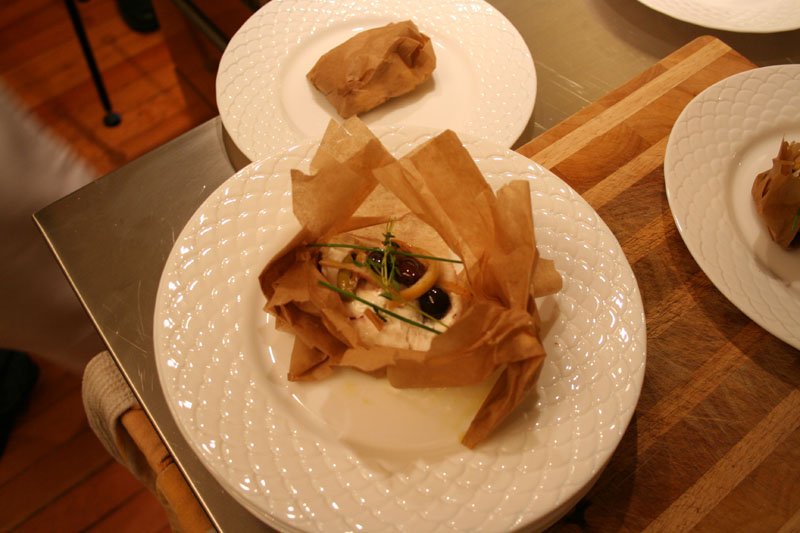

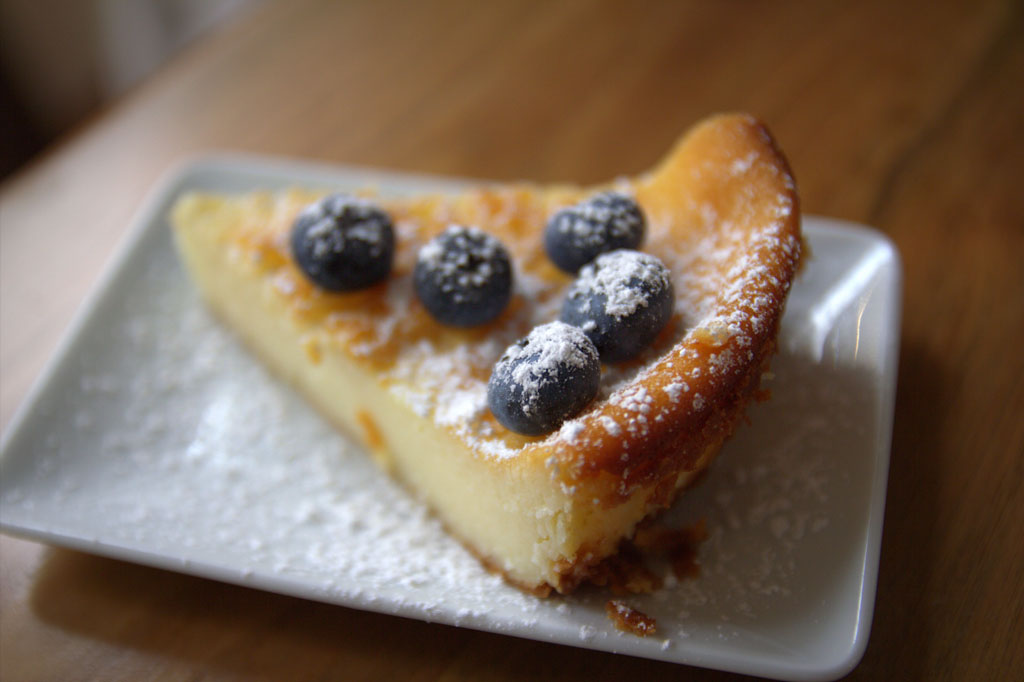
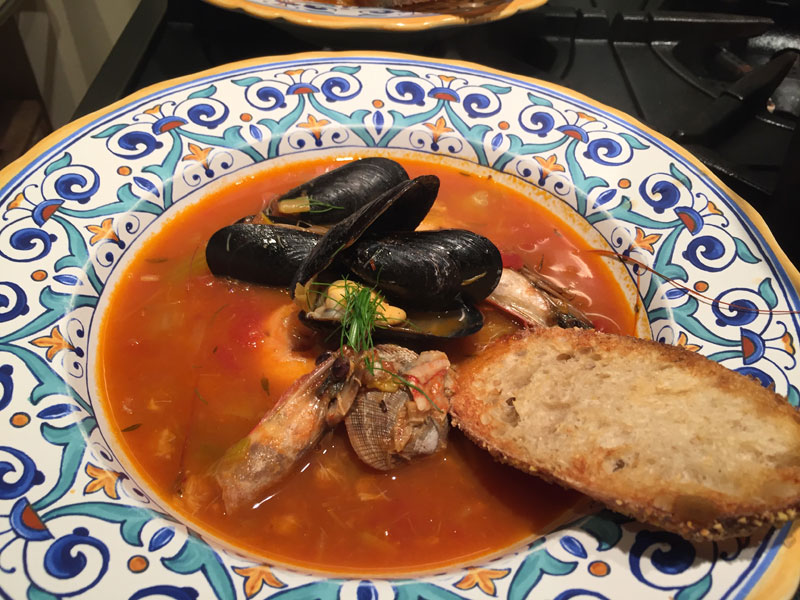
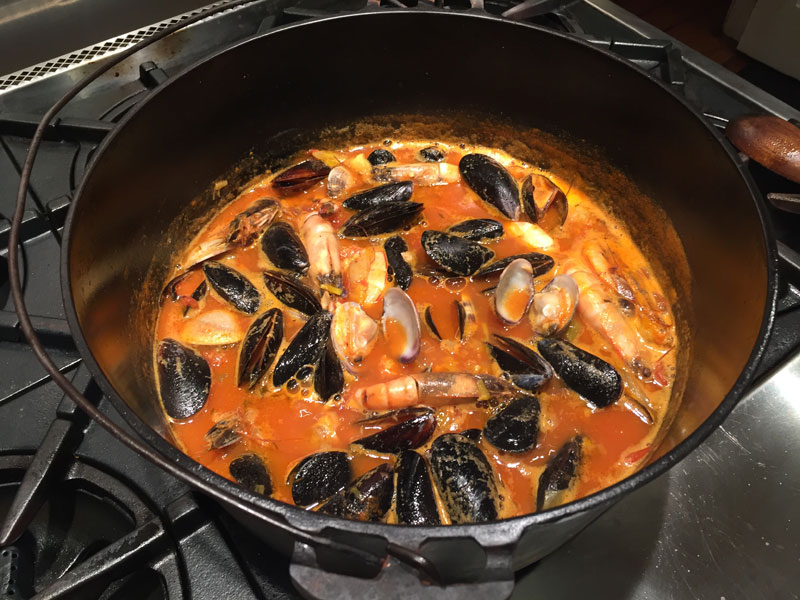
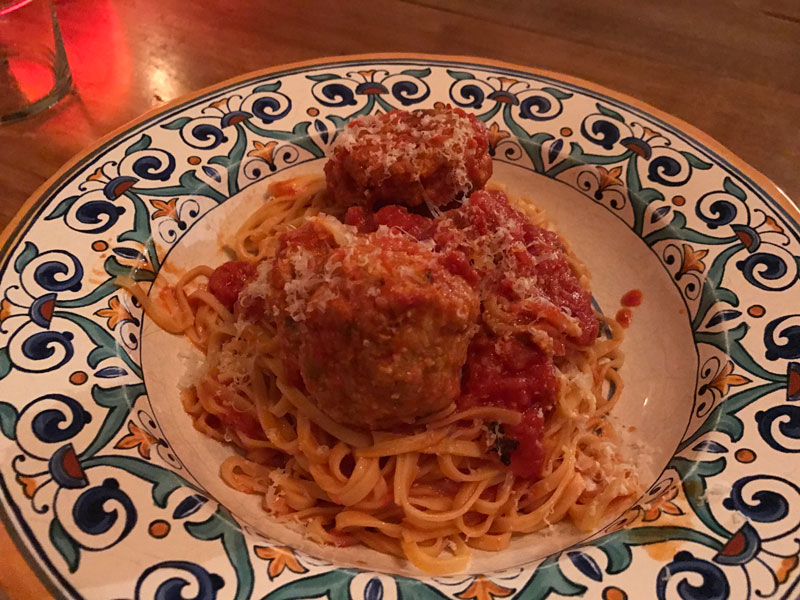
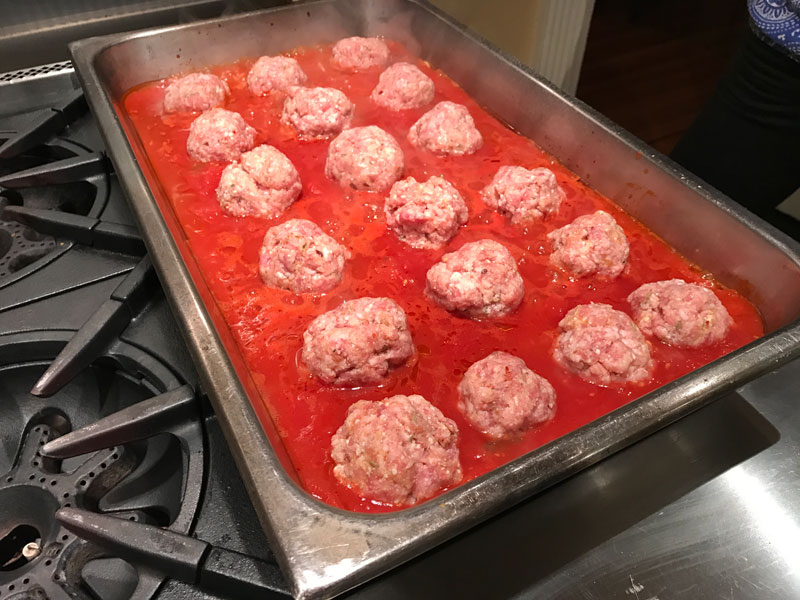
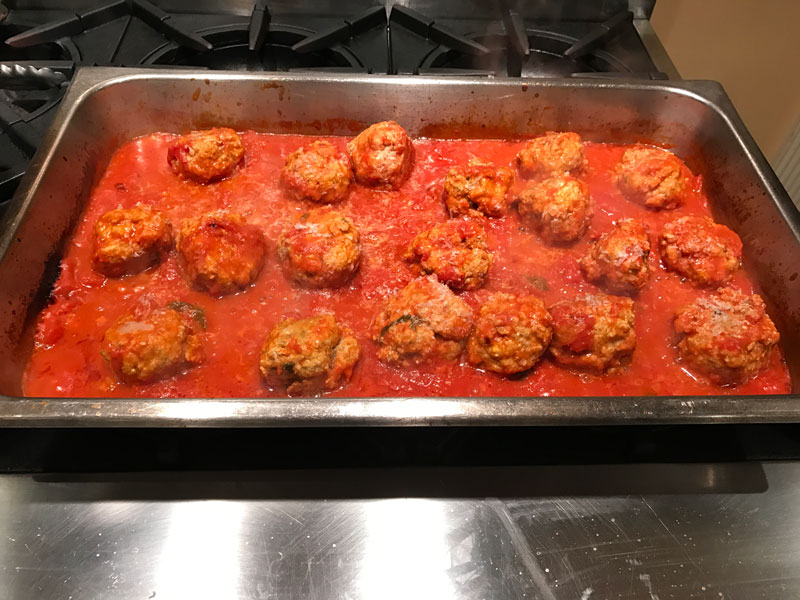
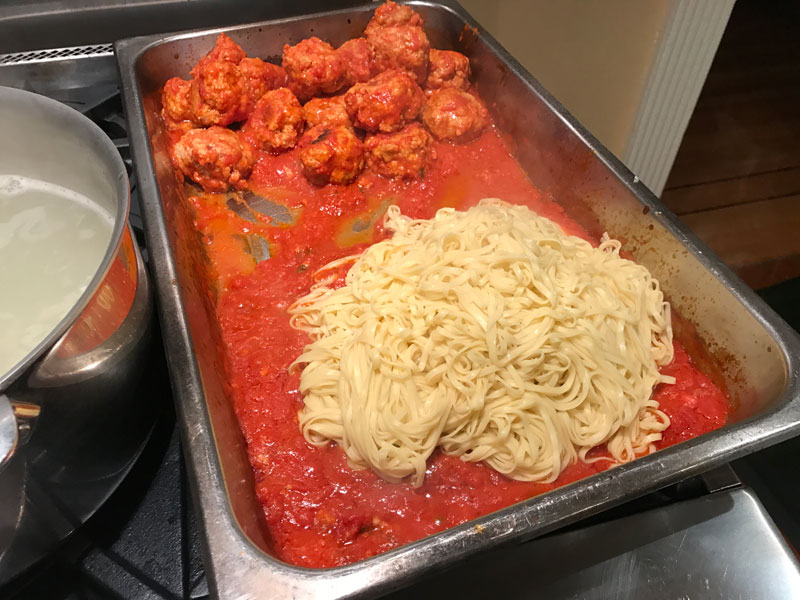
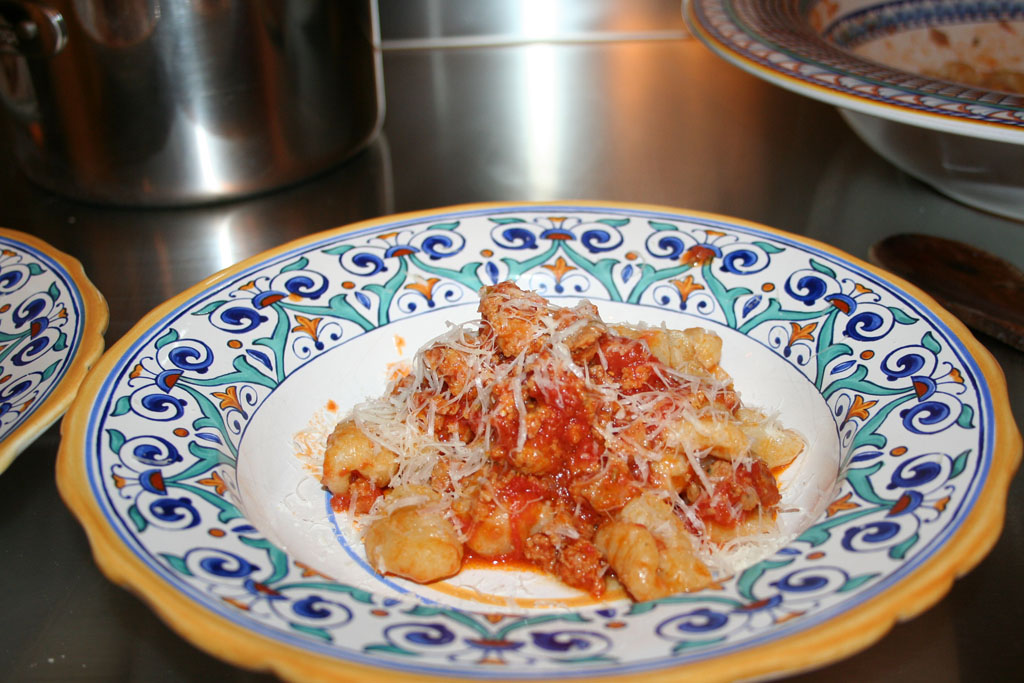
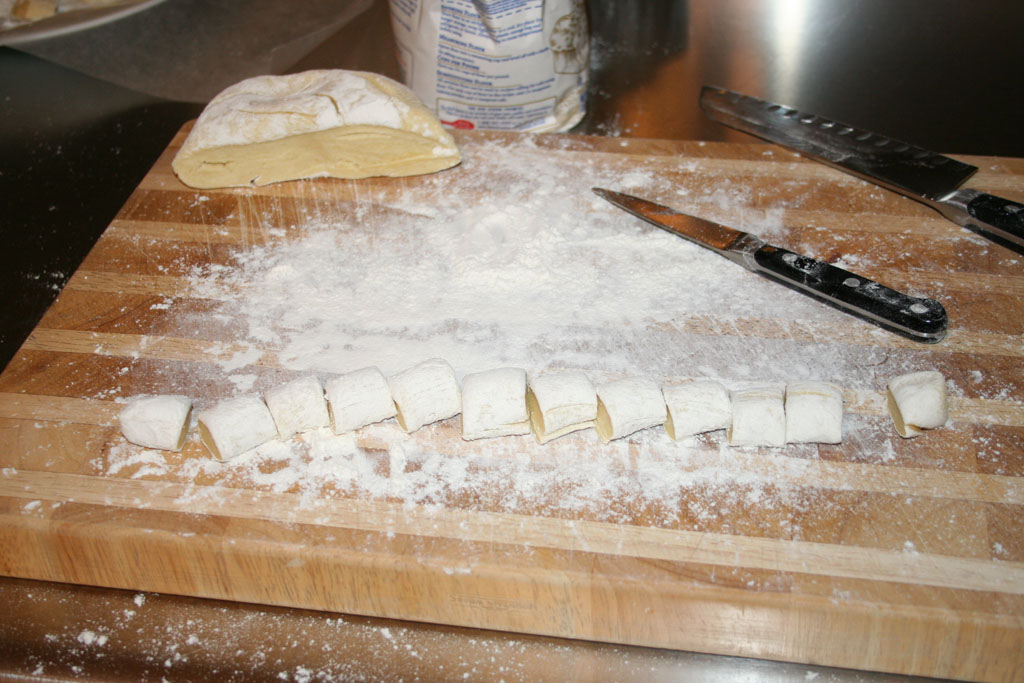
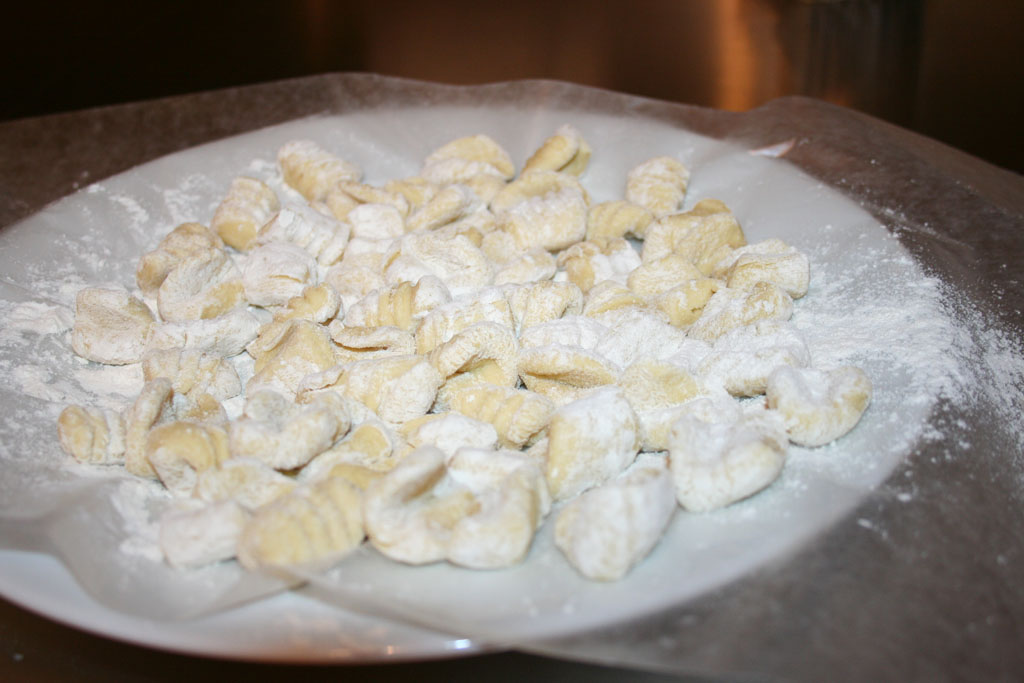
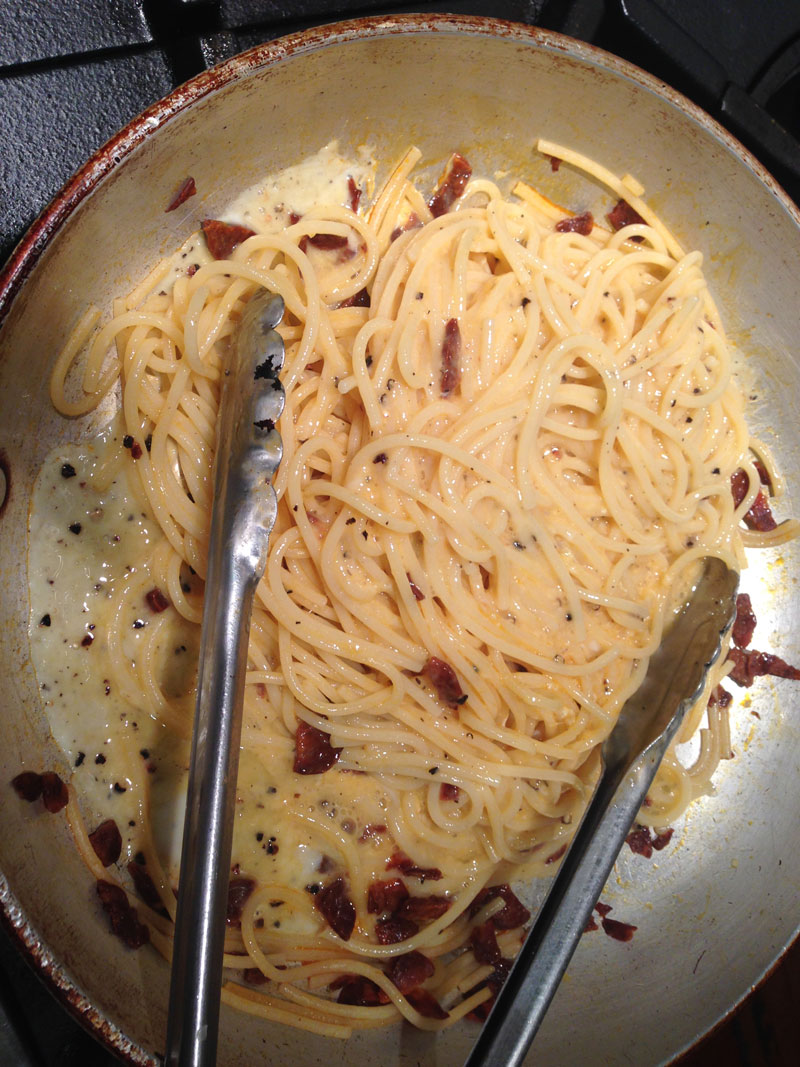
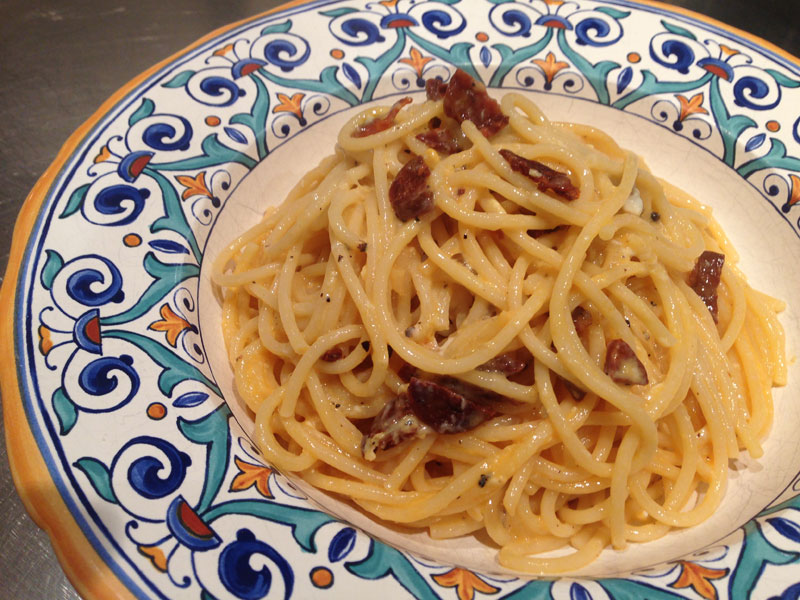
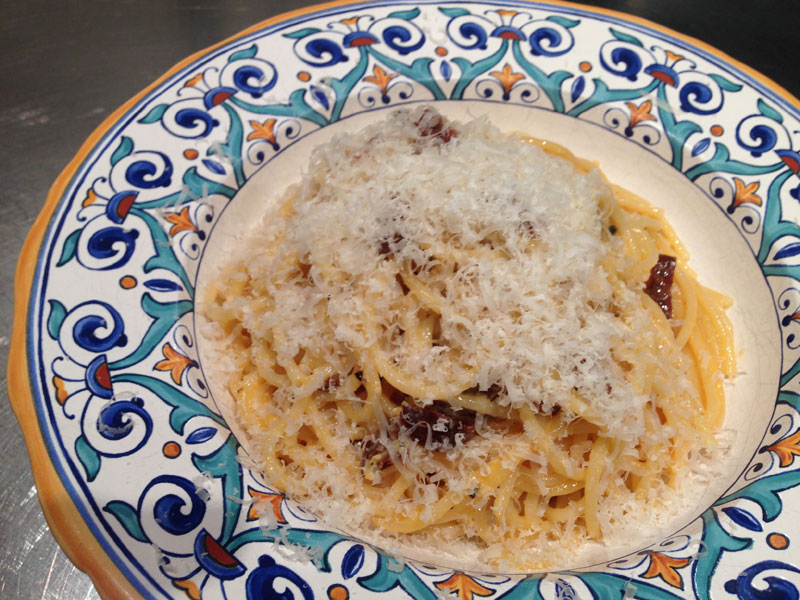
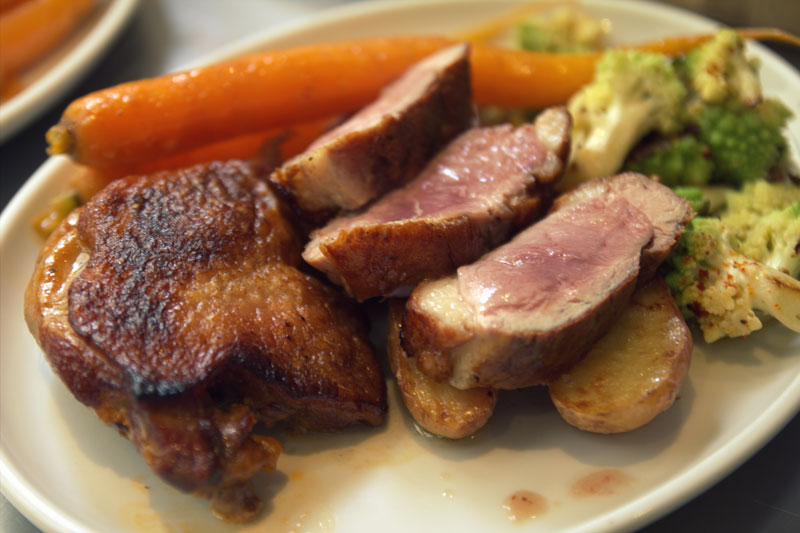
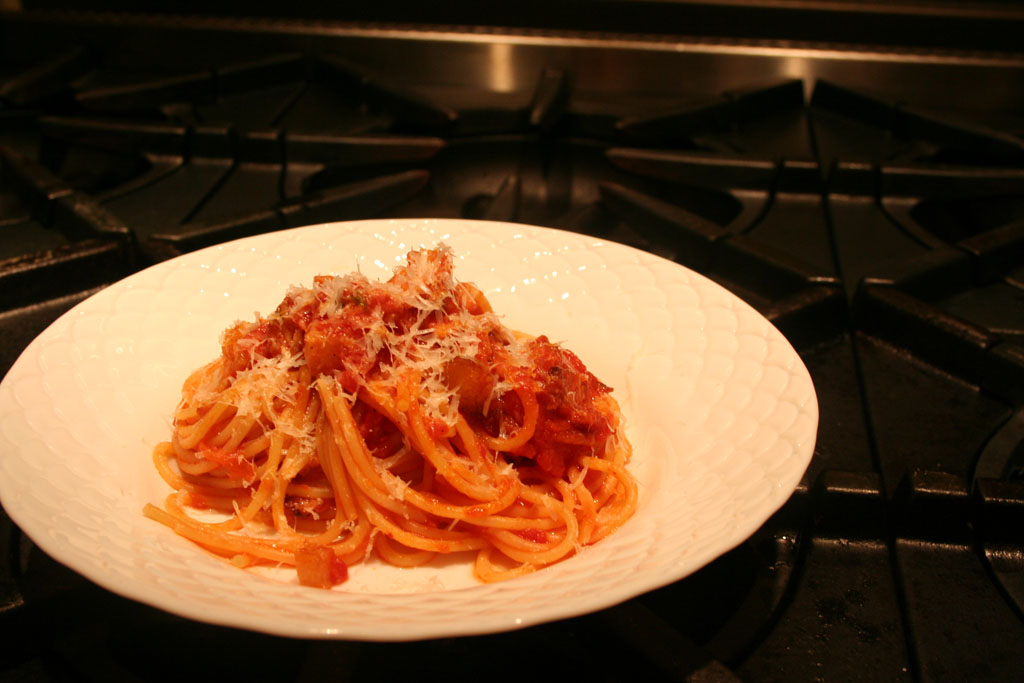
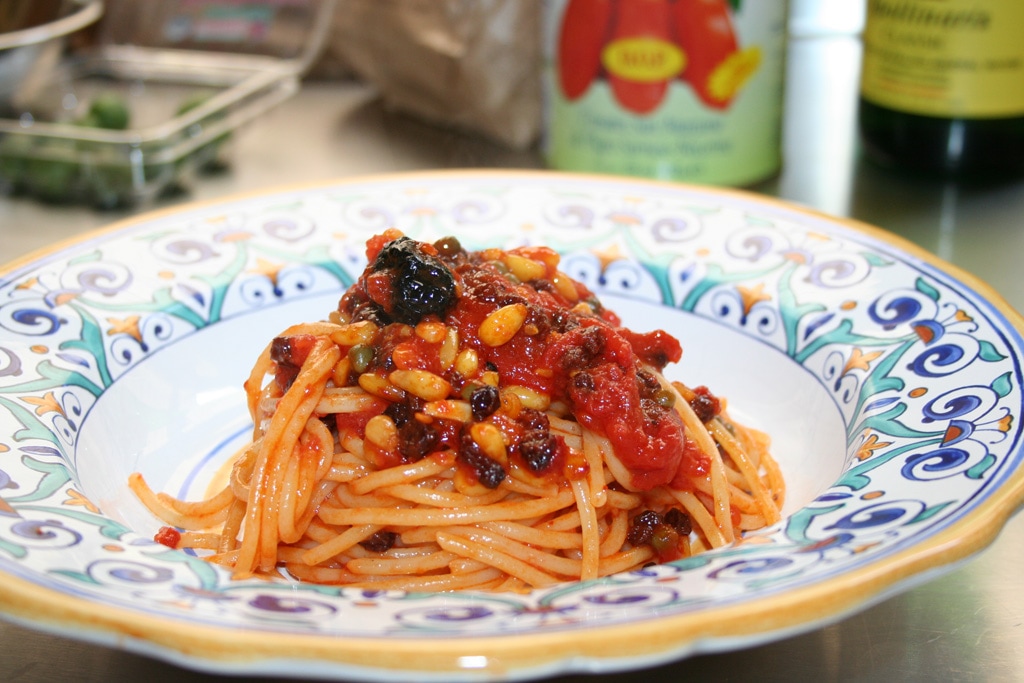
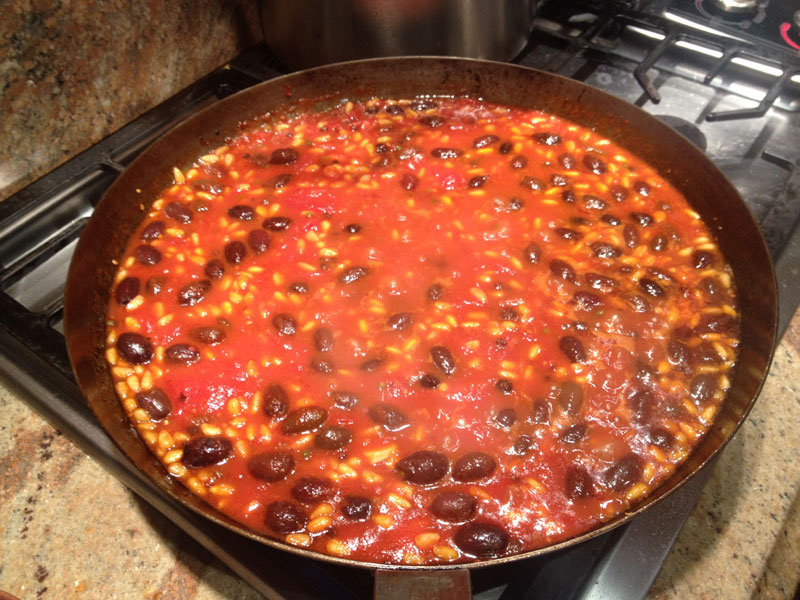
 RSS Feed
RSS Feed